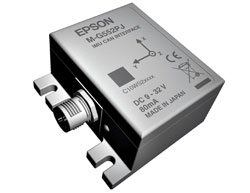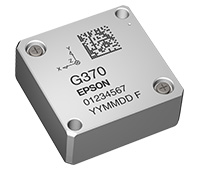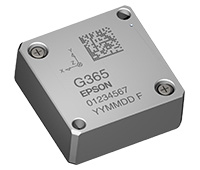Epson IMU ROS1 Node SPI ** Deprecated **
*** NOTE: This package has been superceded by Epson IMU ROS1 Driver Node***
*** This webpage will no longer be updated ***



Contents
Overview
The Epson IMU ROS software is C++ wrapper around a Linux C driver for communicating on a ROS system
- This code assumes that the user is familiar with building ROS1 packages using the catkin build process
- This is *NOT* detailed step by step instructions describing how to build and install this ROS driver
Refer to the README.md inside the package for more detailed up-to-date technical info on usage or Github repository
SPI Connection & Configuration
- Since SPI interfaces are non-standard on PCs, typically IMU SPI interfacing is applicable only to embedded Linux platforms
- When connecting the Epson device to a ROS system using the SPI interface:
- direct connection to SPI port must be compatible with CMOS 3.3V I/O
connection between the host & Epson device is possible using the M-G32EV031 evaluation breakout board
This ROS driver uses the external library Unofficial wiringPi library to generate low level SPI communication & accurate time delays
- Other libraries can be used to generate timer delays and SPI messages but requires minor changes to redirect the low-level function calls (i.e. bcm2835 C library, etc)
Accurate timing delays are necessary to optimize throughput for high dout_rate when using the SPI interface (refer to IMU datasheets for timing specifications)
Below is an example IMU SPI connection when using a Raspberry Pi:
Epson IMU
Raspberry Pi
EPSON_RESET Input
RPI_GPIO_P1_15 (GPIO22) Output
EPSON_DRDY Output
RPI_GPIO_P1_18 (GPIO24) Input
EPSON_CS Input
RPI_GPIO_P1_16 (GPIO23) Output
EPSON_SCLK Input
RPI_GPIO_P1_23 (GPIO11) Output
EPSON_DOUT Output
RPI_GPIO_P1_19 (GPIO10) Input
EPSON_DIN Input
RPI_GPIO_P1_21 (GPIO9) Output
Support for Timer Delays
- There are wrapper functions for time delays in millisecond and microseconds using seDelayMS() and seDelayMicroSecs(), respectively.
On embedded Linux platforms, these may need to be redirected to platform-specific HW delay routines if not using a RaspberryPi
For example on RaspberryPi, the time delay functions for millisecond and microseconds is redirected to WiringPi library delay() and delayMicroseconds() function calls, respectively.
- If a hardware delay is not available from a library, then a software delay loop is possible, but not preferred
Support for GPIO Control
- 3 GPIO pins on the host are designated used and should be connected to the IMU
- GPIO output for asserting CS# on the IMU (NOTE: Not using pin SPI0_CE0)
- GPIO output for asserting RESET# on the IMU
- GPIO input for reading the logic status on the IMU DRDY (GPIO1) pin
- The use of GPIO pins for connecting to the IMU CS# and DRDY is mandatory
- RESET# is recommended to force Hardware Reset during every IMU initialization for better robustness.
ROS1 Node
This ROS driver publishes IMU messages as per REP 145 Conventions for IMU Sensor Drivers
sensor_msgs/Imu - contains header, orientation, angular velocity and linear acceleration
Published Topics
For IMU models that support quaternion output function the orientation field in sensor_msgs/Imu can update with valid data and publish on imu/data
For IMU models that do not support quaternion output function the orientation field in sensor_msgs/Imu will not update with valid data and publish on imu/data_raw
Launch File
The roslaunch/XML in the launch folder of this package is used to pass the init parameters to configure the IMU at runtime using roslaunch
Changes to init parameters is made by editing the launch file which does not require rebuilding with catkin_make
Typically, the user only needs to modify imu_dout_rate & imu_filter_sel as needed based on system requirements
Only use the specific IMU model launch file associated with the same IMU model built using catkin_make
Timestamping With EXT Signal
- The G3xx series Epson IMU has 3.3V I/O EXT (GPIO2) pin which can be connected to a cyclic external sync signal such as a GNSS 1PPS signal
When the init parameter time_correction is enabled in unison with ext_sel set to reset counter & count_out enabled
The ROS driver attempts to correct the time stamp field in sensor_msgs/Imu based on the reset counter value (measured delay since latest GNSS 1PPS)
- This should give a more accurate timestamp of the inertial data by minimizing the effects of link delays or host processing overhead delays
Building & Installing ROS1 Node
1. Place this package (including folders) into a new folder within your catkin workspace "src" folder.
2. Modify the CMakeLists.txt to select the desired Epson IMU model that is being used in the ROS system.
NOTE: You *MUST* re-build using catkin_make when changing IMU models or any changes in the CMakeLists.txt
3. From the catkin workspace folder run "catkin_make" to build all changed ROS1 packages located in the <catkin_workspace>/src/ folder. 4. Reload the current ROS1 environment variables that may have changed after the catkin build process.
<catkin_workspace>/source devel/setup.bash
5. Modify the appropriate roslaunch/XML to set your desired IMU init parameters for the specific IMU model in the launch folder that you selected and built
Typically, only the dout_rate & filter_sel needs to be edited
Running the ROS1 Node
To start the Epson IMU ROS1 driver use the appropriate launch file (located in launch/) with roslaunch
- For example:
<catkin_workspace>/roslaunch ess_imu_ros1_spi_driver epson_g370.launch
Technical Support
For technical support or related issues using this ROS software, please email sensingsystem_support@ea.epson.com
